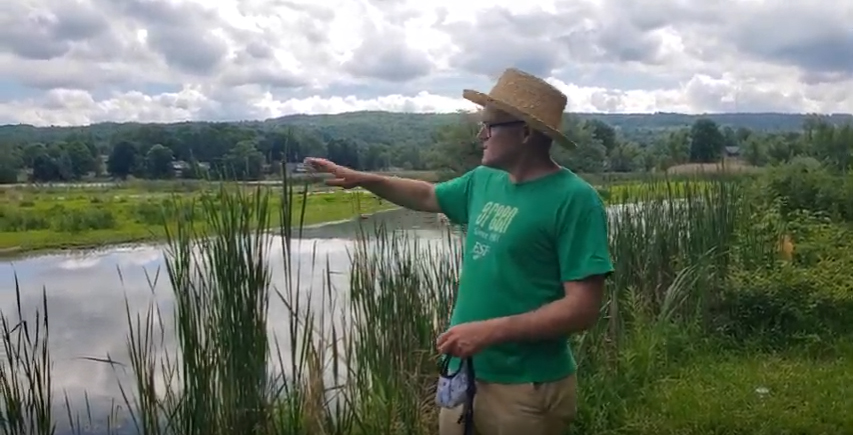Recent Headlines

Dr. Mark Teece at Jamesville Reservoir
What's Causing Islands to Form in Jamesville Reservoir?
Islands are forming in Jamesville Reservoir and Dr. Mark Teece is trying to find the cause and in turn, a solution.
A large amount of sediment and silt from the Butternut Creek is slowly filling in the southern end of the reservoir, which is located 7 miles southeast of the city of Syracuse, New York. The sediment has started forming islands.
"They used to be small islands," said Teece, associate professor from the Department of Chemistry, "but over the last six years, their size has increased massively."
Sedimentation from Butternut Creek may also be affecting some fishes. Dr. Donald Stewart, a fisheries professor at ESF, noted his ichthyology classes have sampled fishes in the southern bay of Jamesville Reservoir every year in spring for almost 20 years. "In recent years, however, a species of sunfishes apparently disappeared from the south bay as the area filled with fine sediments," said Stewart. Keeping the stream water clean also is critical because the creek is a popular trout fishing area.
While some have proposed dredging the reservoir to get rid of the sediment, Teece said it's important to know where the sediment is coming from first.
"If you dredge it and you're not aware of what the problem is, then you've just got a deeper area in the lake, which will fill up again with sediment quickly," said Teece.
While two truckloads of sand are brought into Jamesville Beach yearly, he noted that must go somewhere, but that does not account for the recent large increase in amount of island-creating sediment.
"Most of it seems to be coming down the creek," he said, and "something happened in the creek to increase the sediment."
The first step in understanding the problem was taking samples of the sediment. Teece and environmental chemistry student Bella Luikart worked with the Jamesville Reservoir Lake Association collecting and analyzing several sediment cores.
"Sure enough, there was a major shift in the sediment structure," Teece said. Normally sediment found in the reservoir is organic and rich, but Teece and Luikart found "a big shift to fine particulates - lots of carbonate, which suggests that it could be a new soil coming in or something like gravel."
There are several farms and businesses located up the watershed that could be contributing to the new sediment. There has also been some clear-cutting of trees on some properties that have increased the amount of material going into the creek, according to Teece.
"So multiple things have happened," said Teece. Before the COVID-19 pandemic, Teece planned to survey the watershed using Google Earth images and walking the creek to try to discern where the sediment originated. Those plans are on hold now that his students are working on online projects due to pandemic restrictions.
"We're not interested in placing blame," said Teece, but rather finding the source of the problem and proposing solutions. For example, he said, the New York State Department of Environmental Conservation (DEC) has a Trees for Tributaries program that works to reforest small creeks and streams that flow into larger rivers and lakes. The program's goal is to plant trees and shrubs along streams to create a forested riparian (streamside) buffer that helps decrease erosion, reduce flooding damage, improve wildlife and aquatic habitats, and protect water quality.
"If you'd kayak up the creek, you can see that the sides are being undercut," said Teece, "and so that would be a good place to suggest Trees for Tribs to plant trees and stabilize the banks - if that's an issue."
"If a farm or some other facility in the watershed upstream from the reservoir is responsible for runoff coming from their properties, there are state grants available to help put best management practices in place," he said.
"The idea is to find out what's happening, and then approach those landowners with information about a solution. Knowing what funds may be available and what are the best management practices can help are important first steps to fixing such problems," said Teece.
Click here, to view the video of islands forming in Jamesville Reservoir.